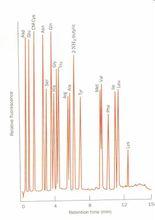Summary
Protein sequencing is mainly relying on chemical or enzymatic digestion methods to separate peptides and detect the amount and composition of amino acid residues. This post will introduce the principles and experimental steps of protein sequencing.
Definition
Currently, the so-called protein sequencing refers to the detection of proteins’ primary structure, which contains the number of polypeptide chains in proteins. Polypeptides and proteins can be used equally in many cases. Amino acid sequence of polypeptides is the biological function of proteins.
Sequencing steps
1. Splitting polypeptide chain
Protein moleculars should be separated and purified. Several polypeptides are combined together by non-covalent bond, which is known as oligomeric protein. For example. 8 mol/L urea or 6mol / L guanidine hydrochloride can be used to deal with tetramer---Hb and dimer---Enolase.
2. Detecting the number of polypeptide in protein moleculars
The number of polypeptides can be determined by detecting the relationship between the number of moles of amino acid residues and protein molecular weight.
3. Breaking disulfide bonds
Several polypeptides chains are linked by disulfide bonds. Disulfide bonds will be reduced to thiol with excessive & [beta]- mercaptoethanol under the condition of 8mol / L urea or 6mol / L guanidine hydrochloride. And then it should be protected by alkyl reagents from re-oxidation.
Cleaving and protecting disulfide bonds
A.performic acid: -CH2SO3H
B.Reduction + oxidation: Mercaptoethanol, DTT +iodoacetic acid, -S-CH2-COOH
C.Sulfurous acid decomposition: -R1-S-S-R2 + HSO3-, R1-S- + R2-S-SOH3
4.Detecting the amino acid composition of polypeptide chains and calculating the molecular ratio of amino acid composition.

5.Sequencing N-terminal and C-terminal of polypeptide chains
Amino acid of polypeptides is divided into two categories: amino-terminal and carboxyl-terminal. The N-terminal is much more important in the analysis of amino acid sequence of peptide chains than C-terminal.
6.Polypeptide can be cleaved into several small peptides. More than two methods can be used to break peptide samples into two or more sets of peptides or peptide fragments and then separate them.
7.Determining the amino acid sequencing of each peptide
8.Determining the sequence of peptide fragments in polypeptide chains
9.Determining the position of disulfide bonds in the original polypeptide chain
Generally, pepsin will be used to deal with those polypeptide chains with disulfide bonds. And then 2D-electrophoresis technology will be used to separate each peptide fragment. Analyzing the composition and sequence of peptide fragments, which may contain disulfide bonds. And then comparing it with other peptide fragments, which are analyzed by other methods, to determine the position of disulfide bonds.
Equipped with state-of-the-art facilities, Creative Proteomics can provide protein identification services with different methods. Our team of experts with extensive experience can help you understand what you are trying to investigate and meet your requirements. Our protein sequencing services include:
- Peptide mass fingerprinting (PMF) service
- Sequence analysis of peptides or proteins
- De novo protein sequence analysis service
- Shotgun protein identification service
- Membrane proteomics service